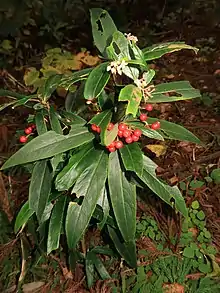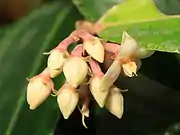| Ardisia crispa | |
|---|---|
_(6076897352).jpg.webp) | |
| Botanical illustration | |
 | |
| Habit | |
| Scientific classification | |
| Kingdom: | Plantae |
| Clade: | Tracheophytes |
| Clade: | Angiosperms |
| Clade: | Eudicots |
| Clade: | Asterids |
| Order: | Ericales |
| Family: | Primulaceae |
| Genus: | Ardisia |
| Species: | A. crispa |
| Binomial name | |
| Ardisia crispa | |
| Synonyms[1] | |
|
List
| |
Ardisia crispa, the Japanese holly, is a species of flowering plant in the family Primulaceae.[2] It is found in the eastern Himalayas, Assam, southern China, Indochina, Taiwan, Korea, the Ryukyu Islands, and Japan, and has been introduced to Queensland, Australia, and the Windward Islands in the Caribbean.[1] An evergreen perennial shrub reaching at most 1.5 m (5 ft), it is often sold as an ornamental for its dark green leaves and long‑lasting red berries, much like Ardisia crenata, the Christmas berry or coralberry.[3][4][5]
 Flowers
Flowers Fruit
Fruit
References
- 1 2 "Ardisia crispa (Thunb.) A.DC". Plants of the World Online. Royal Botanic Gardens, Kew. Retrieved 18 April 2022.
- ↑ "Ardisia crispa (ADACR)". EPPO Global Database. European and Mediterranean Plant Protection Organization. 2022. Retrieved 18 April 2022.
- ↑ Fern, Ken (30 July 2021). "Useful Temperate Plants Ardisia crispa". temperate.theferns.info. Temperate Plants Database. Retrieved 18 April 2022.
- ↑ "Ardisia crispa Christmas berry [3]". The Royal Horticultural Society. 2022. Retrieved 18 April 2022.
- ↑ "Ardisia crispa (coral berry)". Invasive Species Compendium. CAB International. 22 November 2019. Retrieved 18 April 2022.
This article is issued from Wikipedia. The text is licensed under Creative Commons - Attribution - Sharealike. Additional terms may apply for the media files.